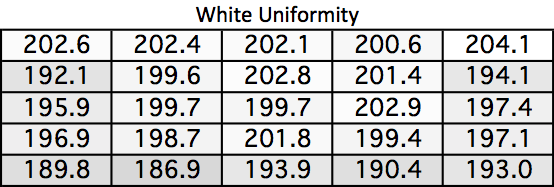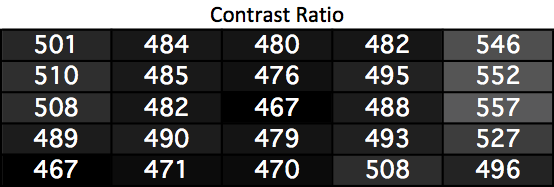Samsung S27B971D Monitor Review
by Chris Heinonen on October 31, 2013 12:00 PM ESTThe only way to describe the uniformity data is “also amazing.” Rivaling or even exceeding what I have seen from NECs professional displays, the uniformity of the S27B971D is superb. White uniformity is all within 8% of each other, which is likely to not be noticed in real life. Even the dimmest area on the screen only drops by 6% which I did not notice when using it. Like NEC the high-brightness setting probably affects uniformity as well, but using the sRGB mode it stays incredibly uniform.


Black levels have more of a fall-off but not for the usual reason. Typically black uniformity is bad because of some bright corners or edges, but here it is less uniform because the edges are darker. I’m not going to complain about this as it is much better than having bright corners around the screen. I’m assuming the higher overall black levels are due to the technology they are using to produce the uniformity in the display. As I mentioned with the calibration bench, if you need contrast ratios, you can use the movie mode for that. For work where color accuracy and uniformity are more important the sRGB mode is perfect.


With our white levels being totally stable the contrast uniformity varies due to the black levels. The good news is that it varies in a good way, with the edges of the screen being more dynamic than the center. It never exceeds 557:1 so it still lacks the pop of a VA panel, but it is very stable across the screen.


Saving the best for last, color uniformity is perfect. Only two values exceed 1.0 dE2000 on average when compared to the center, and the largest average is 1.23. When you look at an image on the screen, colors will match the rest of the screen and everything will look correct. Phenomenal results here from Samsung.

Despite Samsung billing this as a professional display, I didn’t expect these kinds of results. Even when I saw their 25-point calibration demo or the document that came with the display I didn’t expect it. However Samsung has made a display that ranks up with displays costing hundreds of dollars more in terms of uniformity and accuracy.










52 Comments
View All Comments
Alan G - Saturday, November 2, 2013 - link
Yes, writing to the monitor's LUT which is why NEC monitors are so easy to work with. I've used both their own Spectraview software or the ArgylCMS freeware to calibrate it. Of course the needs of photographers are quite different from those who game on their computer for which this monitor might be sufficient.Gothmoth - Saturday, November 2, 2013 - link
well EIZO or QUATO is the goto. but NEC spectravies are not bad below 2000 euro.bobbozzo - Friday, November 1, 2013 - link
Hi, please include the Aspect Ration on the specs chart on the first page of all monitor reviews.This one appears to be 16:9 :(
Thanks!
bobbozzo - Friday, November 1, 2013 - link
arg... Aspect Ratio!AnnonymousCoward - Friday, November 1, 2013 - link
30ms lag is unacceptable, and 67% gamut is bound to look dull next to a wide gamut playing any game. Too expensive, too.Gothmoth - Saturday, November 2, 2013 - link
test EIZO and QUATO monitors... why do you test all the dell and samsung consumer stuff but not the more pro oriented monitors out on the market?eizo CX240 or CX270... they are the competition to the NEC PA271 or PA272.
not these dell or samsung monitors.
cheinonen - Sunday, November 3, 2013 - link
As soon as Eizo or Quato will send me a display I'll test one. Until then I can't!hoboville - Monday, November 4, 2013 - link
Holy cow, I was thinking "Hmm this is a nice monitor, I've been wanting to get 1440p". Then I saw the price. What are they thinking?JakeLee - Tuesday, November 5, 2013 - link
Aren't you people aware that Samsung got caught cheating customers with fake calibration reports last year?Part 1: (partially English)
http://colormgmt.com/60166005864
Part 2: (Korean only)
http://colormgmt.com/60166308743
Samsung's excuse (Korean)
http://samsungtomorrow.com/2914
They admitted that the reports are "accidentally" misprinted, although the monitors are hand calibrated each through four stages.
It might be true, but Samsung has a very long list of shady practices....
cheinonen - Tuesday, November 5, 2013 - link
Thanks for posting that. I hadn't seen that before so it is good to see. That would certainly explain why the measurements on the included data sheet didn't match up to the performance I measured with CalMAN myself.